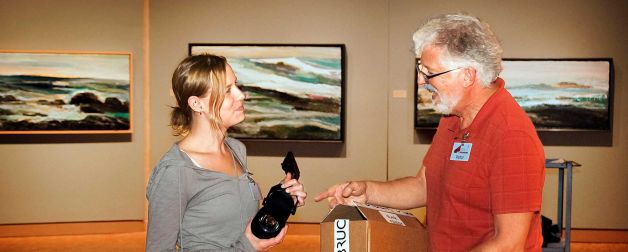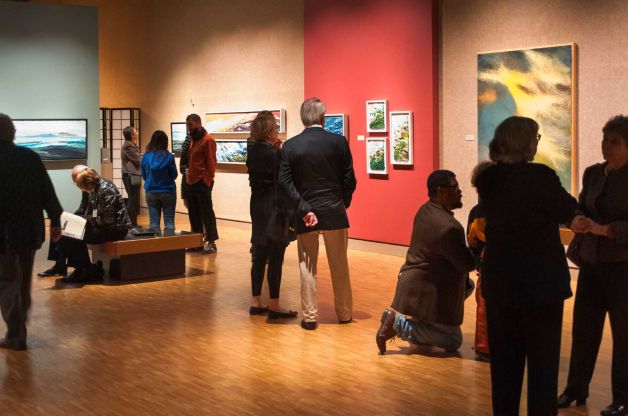A spectacular collection of original oil paintings by emeritus Indiana University art professor Barry Gealt is on display in the IU Art Museum's Special Exhibitions Gallery, along with exhibits of baby carriers from China's minority groups and German expressionism.

In this Sept. 26, 2012 photo, Indiana University Department of Theater and Drama professor Rob Shakespeare talks with graduate assistant Lee Burckes about the LED lighting system he designed for for IU Art Museum Special Exhibitions Gallery, in Bloomington, Ind.
But look toward the ceiling instead of what's hanging on the walls, and it is evident that the paintings are illuminated by clean, cool, white lights, while the other exhibits bask in a warm, yellowish glow.
"It's like apricot soup," said IU theater professor Rob Shakespeare of the traditional incandescent lighting on the baby carriers and textiles, and in all the museum's other galleries.
Shakespeare, an expert in theater and architectural lighting and creator of the "Light Totem" in front of the museum, designed the LED lighting system for the "Barry Gealt: Embracing Nature, Landscape Paintings 1988-2012" exhibit, on display through Dec. 23.
It's the museum's first use of LED lighting, but something it hopes to expand when as can finds funding for the investment, exhibit curator Linda Baden told The Herald-Times.
When the museum was built 30 years ago, I.M. Pei's architectural design was state of the art, Shakespeare said. And until now, gallery lighting was traditional.
"It's innovative of the museum to take this step," Baden said.
LED lamps — they're not bulbs — use a fraction of the electricity required to provide the same amount of light as incandescent bulbs. They're even more energy efficient than compact fluorescent bulbs, and unlike CFLs, they're dimmable.
Shakespeare said the 60 or so LED lamps in use in the gallery use 12 to 15 watts each, compared with the 90-100 watts used by each of the incandescent bulbs they replaced.
He explained that 70 or 80 percent of the energy incandescent bulbs use ends up as unwanted heat, while LEDs produce only light.
That will reduce the museum's energy need for air conditioning as well.
And for illuminating art, LEDs have another advantage: The spectrum of light they produce is balanced, reproducing natural light. No more apricot soup, and more important, the infrared rays that incandescent bulbs produce can bake art, Shakespeare said, and at the other end of the light spectrum, ultraviolet rays destroy organic pigments.
Older electric lighting, with a "big spike in the spectral curve" fades paintings and prints unevenly, Shakespeare said, permanently turning yellows into grays, for example.
Even new-technology LED lights will cause pigments to fade with time, but at least the colors will fade evenly and more slowly, he said.
In addition to being gentler on art and using less electricity, LED lighting has another advantage: a projected life of 50,000 hours, compared with 2,000 hours or less for incandescent bulbs.
That's significant waste reduction, and will allow museum staff to attend to more useful work than changing light bulbs so frequently, Shakespeare said.
But there are disadvantages to LED lighting, too. Most notably, the new technology, long-life lamps cost at least 10 times as much as incandescent bulbs.
The museum's lighting, including a flexible new electrified track support system that crisscrosses the gallery's ceiling, cost $80,000.
It's expected to last for decades, though, and will take a noticeable bite out of the museum's electric bill each year.
Another disadvantage is that LED technology is evolving. Shakespeare worked with Bruck Lighting on the specialized lamps for the art museum's LED lamps, but called those available off the shelf "disappointing." Those who want LED lighting for their homes might want to wait a while longer before investing.

In this Oct. 6, 2012 photo, Indiana University Art Museum visitors view an exhibition illuminated with energy efficient, art-preserving LED lighting in the Special Exhibitions Gallery. "Barry Gealt: Embracing Nature," on view in the gallery in Bloomington, Ind.





